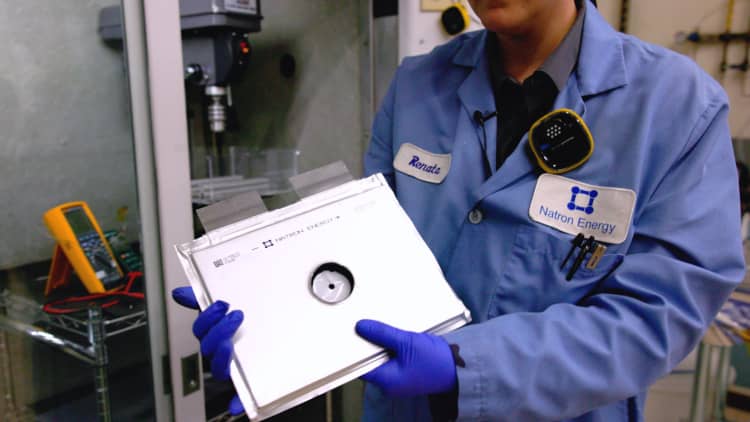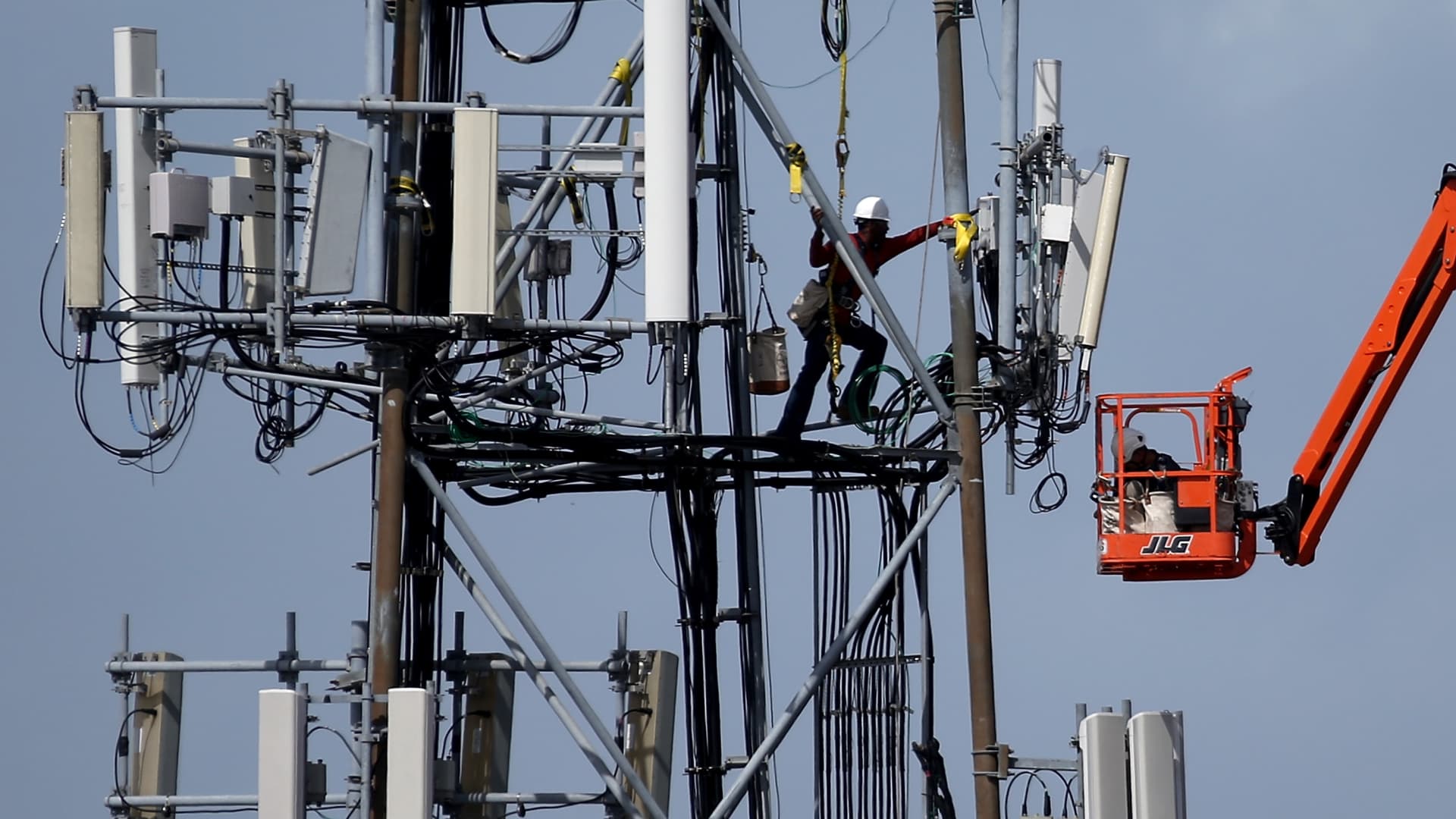
Cameron Dales (L), president and chief commercial officer of Peak Energy, and Landon Mossburg, the CEO of Peak Energy, on a hike in the earliest days of the company. The mountains of Colorado in the background inspired the name of the company, Peak Energy.
Photo courtesy Peak Energy
Battery industry veterans are coming together to launch Peak Energy, which aims to mass-produce giant batteries to even out production fluctuations from renewable energy sources, like wind and solar power generators.
Because Peak Energy is focused on scaling up production of battery technology that already exists, they don’t think of themselves as a traditional “startup.”
“A normal Silicon Valley startup is 10 years in the lab, come up with a better mousetrap and go to market. We’re completely the opposite,” Cameron Dales, president and chief commercial officer of Peak Energy, told CNBC in a video interview Friday.
Peak Energy hopes to partner with a technology company (yet to be selected) that is already an expert in battery technology but does not have the capacity to scale manufacturing.
“In the battery market it turns out the rarest commodity is not the technology — there are many excellent ideas out there at academic labs and startups — but rather the ability to scale to manufacturing,” CEO Landon Mossburg told CNBC. “The difficulty of manufacturing scale up is one of the reasons you see so many ‘breakthrough battery technology’ announcements but very very few companies who actually reach market.”
Peak Energy launched in June and is coming out of stealth on Wednesday, announcing a $10 million funding round lead by Greg Reichow at Eclipse, a Silicon Valley venture capital firm. Before joining Eclipse, Reichow worked at Tesla for more than five years, where he was responsible for battery, motor and electronics manufacturing and then led global manufacturing. Also joining the funding raise is TDK Ventures, the corporate venture capital arm of the Tokyo-headquartered multinational electronics company TDK.
“The No. 1 issue we face as it relates to expanding renewable energy sources is storage,” Reichow told CNBC. “This problem must be solved, but the existing approaches using lithium-ion and other technologies are not yet at a price point that enables the kind of scaling that society needs across sectors.”
Demand for grid-scale storage will continue to grow. The United States Energy Information Administration has projected that battery storage capacity will grow from 9 gigawatts in 2022 to 49 gigawatts in 2030 and then to 247 gigawatts in 2050. That’s a baseline projection that includes the Inflation Reduction Act and assumes no additional changes in U.S. policy throughout the projection period.
(L to R) Ryan Gibson, Eclipse Venture partner; Landon Mossburg, Peak Energy CEO; Aidan Madigan-Curtis, Eclipse partner and Cameron Dales, Peak Energy president and chief commercial officer, in protective gear at a battery factory clean room.
Photo courtesy Peak Energy
A stacked team with aggressive growth goals
Peak Energy is still in its very early days. There are about 10 employees and a business office in San Francisco.
But that headcount will triple in coming months, and Peak Energy aims to build its first prototype battery systems, with individual batteries bound together into larger systems using batteries sourced from a third party in 2024. By 2030, Peak says it will be producing “double digit gigawatt” quantities of battery cells for its own battery systems and for other applications.
That’s no small feat. It takes between $50 million and $100 million per gigawatt to build a battery factory, and a 30-gigawatt factory would employ between 2,000 and 3,000 people and be between 1 and 2 million square feet, Mossburg told CNBC.
It’s an aggressive and expensive buildout plan, but Mossburg has done this kind of rapid production scale up before when he worked at Northvolt, a battery manufacturing company that launched in 2016 in Sweden. Northvolt was founded by Peter Carlsson, who was the global head of sourcing and supply chain at Tesla from 2011 to 2015, and Mossburg joined 2017. After 18 months, Northvolt had 300 people, and grew to 4,000 people by the time Mossburg left four years later.
Cameron Dales and US Representative Rho Kana in 2021 at the Enovix battery factory in Fremont, Calif.
Photo courtesy Cameron Dales
Of course, Peak Energy will have to raise more money to fund this kind of expansion. A lot more.
“We’re running a playbook which I and the rest of the executive team initially demonstrated and deployed at Northvolt,” Mossburg told CNBC. Northvolt also started with a small seed round of funding and ended up raising more than $9 billion in a combination of equity and debt. Mossburg was involved with securing all of that financing except for the most recent $1.2 billion announced in August.
Dales has similar experience. He co-founded a material sciences innovation company, Symyx Technologies, which went public in 1999, then joined the battery company Enovix.
“I thought naively, ‘Well, how hard could batteries be? It’s just a plus and a minus, everybody has a Duracell. How hard could it be?’ Little did I know, 14 years later, I would still be there,” Dales told CNBC. Enovix was making very high energy density batteries at a battery factory in Fremont, California, and is building another one in Penang, Malaysia. The company went public in a billion-dollar-plus SPAC deal in 2021.
“Peak Energy’s team comprises of two industry veteran leaders who have scaled a battery company before,” Anil Achyuta, who lead the investment for TDK Ventures, said in a written statement shared with CNBC.
So, too, for Eclipse.
“Landon and I worked together at Tesla and I know what he’s capable of delivering,” Reichow told CNBC. “After leaving Tesla, he went on to build a battery company as an executive at Northvolt. Similarly, Cam was a core part of the founding team at Enovix and was instrumental in helping them build the business. These are proven executives that have built battery companies in some of the hardest spaces and that makes them unique.”
Why Peak Energy is focusing on sodium ion
Peak Energy is focused on making large sodium-ion battery systems to pair with wind and solar energy production facilities. Large grid-scale batteries can capture the energy generated from renewable sources, then hold that energy and dispatch it later when the wind isn’t blowing or the sun isn’t shining.
Peak Energy will make individual battery cells, about the size of a loaf of bread, says Dales. Then those loaf of bread battery cells get wired together to make modules, which would be about the size of a filing cabinet. Then those filing cabinets will be assembled into a battery the size of the back of a tractor trailer truck, then deployed near a solar or wind farm, 50 to 100 at a time.
One hundred blocks can power 62,500 homes for four hours, Mossburg told CNBC.
An artist rendering of the Peak Energy battery system.
Rendering courtesy Peak Energy.
The most typical battery technology right now is lithium ion, used in cellphones and electric vehicles, and they are prized for their energy density. Sodium-ion batteries are less energy dense and heavier — bad for mobile devices or cars, but less relevant when it comes to grid-scale batteries.
“Weight, and therefore energy density, is much less important in a stationary storage system. The fact that these batteries are less energy dense isn’t really a big consideration for this application,” Reichow told CNBC.
What does matter when you are talking about storing huge quantities of energy is the cost.
“A much more important consideration is the cost per unit energy that you’re able to store and that is where sodium ion, we believe, will have a big advantage over lithium ion in the future,” Reichow told CNBC.
It’s too early for Peak Energy to commit to a specific price for its battery systems, but a Tesla Megapack battery system costs about $1.3 million without installation, and Mossburg says he thinks Peak Energy can be at roughly half of that cost with its system.
In addition, lithium-ion batteries can be a fire hazard and the electric vehicle makers are eating up all available supply, Dales told CNBC. The problem utilities have is “the minute Ford or GM needs more batteries, basically their contracts for lithium ion just get canceled and the suppliers just go for the car, because it’s today the largest market,” Dales told CNBC.
Also, China dominates the battery market and supply chains right now. “They’re the dominant player in batteries generally — by far — they are massive in terms of battery production,” Mossburg told CNBC. “And they’re positioning to do the same with sodium.”
Alun Thomas, Head of Manufacturing Engineering at Peak Energy, inside a battery production machine.
Photo courtesy Peak Energy
While Mossburg says he thinks it is a benefit for the world for the United States and China to continue to trade, and Peak Energy is willing to work with Chinese partners, there are geopolitical risks associated with depending on China completely. Peak Energy’s plan to manufacture in the United States is a geopolitical advantage, he says. (It’s also more climate-conscious to make these giant batteries in the U.S. as opposed to making them in China and shipping them to the U.S.)
“You don’t want to be in a situation where a critical component of the energy infrastructure of your entire economy, which batteries are increasingly becoming, is principally sourced from a party that you can’t be sure you’re going to be friends with,” Mossburg told CNBC. “If the U.S. wants to continue to have a robust economy, especially an economy that can make things like cars or even like high-tech things, ceding an entire industry that’s this important to any other player — doesn’t matter if it’s China or anyone else — is a dangerous prospect.”
The first real gigantic battery factory in the world was the Tesla/Panasonic Gigafactory in Nevada, and Reichow led the development of that, Dales said. The second generation “arguably” was the factories that Mossburg built with Northvolt and that Dales helped build at Enovix, Dales said. Peak Energy is “taking that learning and the people who developed those factories and we are going after the third generation of factory design,” Dales told CNBC.








